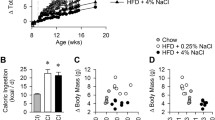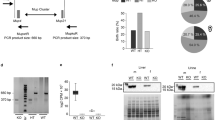Abstract
The peptide transporter PEPT2 mediates cellular uptake of di- and tripeptides driven by an inwardly directed electrochemical proton gradient. In mammals PEPT2 is found in a variety of organs such as kidney, lung, brain, enteric nervous system, and mammary gland. Highest expression levels are observed in renal proximal tubules where PEPT2 contributes to reabsorption of filtered di- and tripeptides. To assess the physiological importance of the transporter in overall metabolism, we have generated a Pept2 −/− mouse line that lacks a functional PEPT2 protein. Here we present data on body weight, organ weights, and blood pressure. Mice were then fed diets containing either 10, 20, or 30% (w/w) protein, and food and water intake rates as well as plasma and urine parameters were determined. In spite of PEPT2 expression in a variety of tissues, only subtle phenotypic changes were observed. Male PEPT2 null mice displayed lower bodyweight and lower relative heart weight, whereas, relative kidney weight was lower in female Pept2 −/− mice. No differences were found in blood pressure. When fed diets with different protein contents, Pept2 −/− mice adapted food intake to dietary protein content with higher consumption rates on low protein and reduced food intake rates on the high protein diet.

Similar content being viewed by others
References
Adibi SA (1997) Renal assimilation of oligopeptides: physiological mechanisms and metabolic importance. Am J Physiol 272:E723–E736
Botka CW, Wittig TW, Graul RC, Nielsen CU, Higaka K, Amidon GL, Sadee W (2000) Human proton/oligopeptide transporter (POT) genes: identification of putative human genes using bioinformatics. AAPS PharmSci 2(2):E16
Chee KM, Romsos DR, Bergen WG, Leveille GA (1981) Protein intake regulation and nitrogen retention in young obese and lean mice. J Nutr 111:58–67
Cheung HS, Wang FL, Ondetti MA, Sabo EF, Cushman DW (1980) Binding of peptide substrates and inhibitors of angiotensin-converting enzyme. Importance of the COOH-terminal dipeptide sequence. J Biol Chem 255:401–407
Cvetkovic B, Sigmund CD (2000) Understanding hypertension through genetic manipulation in mice. Kidney Int 57:863–874
Daniel H (2004) Molecular and integrative physiology of intestinal peptide transport. Annu Rev Physiol 66:361–384
Daniel H, Kottra G (2004) The proton oligopeptide cotransporter family SLC15 in physiology and pharmacology. Pflugers Arch 447:610–618
Daniel H, Rubio-Aliaga I (2003) An update on renal peptide transporters. Am J Physiol Renal Physiol 284:F885–F892
Dziuba J, Minkiewicz P, Nalecz D, Iwaniak A (1999) Database of biologically active peptide sequences. Nahrung 43:190–195
Fei YJ, Ganapathy V, Leibach FH (1998) Molecular and structural features of the proton-coupled oligopeptide transporter superfamily. Prog Nucleic Acid Res Mol Biol 58:239–261
Filho JC, Hazel SJ, Anderstam B, Bergstrom J, Lewitt M, Hall K (1999) Effect of protein intake on plasma and erythrocyte free amino acids and serum IGF-I and IGFBP-1 levels in rats. Am J Physiol 277:E693–E701
Li G-HLG-WS, Yong-Hui; Shrestha, Sundar (2004) Angiotensin I-converting enzyme inhibitory peptides derived from food proteins and their physiological and pharmacological effects. Nutr Res 24:469–486
Lin CJ, Smith DE (1999) Glycylsarcosine uptake in rabbit renal brush border membrane vesicles isolated from outer cortex or outer medulla: evidence for heterogeneous distribution of oligopeptide transporters. AAPS PharmSci 1:E1
Matsui T, Li CH, Osajima Y (1999) Preparation and characterization of novel bioactive peptides responsible for angiotensin I-converting enzyme inhibition from wheat germ. J Pept Sci 5:289–297
Matsui T, Tamaya K, Seki E, Osajima K, Matsumo K, Kawasaki T (2002) Absorption of Val-Tyr with in vitro angiotensin I-converting enzyme inhibitory activity into the circulating blood system of mild hypertensive subjects. Biol Pharm Bull 25:1228–1230
Meissner B, Boll M, Daniel H, Baumeister R (2004) Deletion of the intestinal peptide transporter affects insulin and TOR signaling in Caenorhabditis elegans. J Biol Chem 279:36739–36745
Palacin M, Estevez R, Bertran J, Zorzano A (1998) Molecular biology of mammalian plasma membrane amino acid transporters. Physiol Rev 78:969–1054
Pastore A, Massoud R, Motti C, Lo Russo A, Fucci G, Cortese C, Federici G (1998) Fully automated assay for total homocysteine, cysteine, cysteinylglycine, glutathione, cysteamine, and 2-mercaptopropionylglycine in plasma and urine. Clin Chem 44:825–832
Remesy C, Moundras C, Morand C, Demigne C (1997) Glutamine or glutamate release by the liver constitutes a major mechanism for nitrogen salvage. Am J Physiol 272:G257–G264
Rubio-Aliaga I, Boll M, Daniel H (2000) Cloning and characterization of the gene encoding the mouse peptide transporter PEPT2. Biochem Biophys Res Commun 276:734–741
Rubio-Aliaga I, Daniel H (2002) Mammalian peptide transporters as targets for drug delivery. Trends Pharmacol Sci 23:434–440
Rubio-Aliaga I, Frey I, Boll M, Groneberg DA, Eichinger HM, Balling R, Daniel H (2003) Targeted disruption of the peptide transporter Pept2 gene in mice defines its physiological role in the kidney. Mol Cell Biol 23:3247–3252
Ruhl A, Hoppe S, Frey I, Daniel H, Schemann M (2005) Functional expression of the peptide transporter PEPT2 in the mammalian enteric nervous system. J Comp Neurol 490:1–11
Sakata K, Yamashita T, Maeda M, Moriyama Y, Shimada S, Tohyama M (2001) Cloning of a lymphatic peptide/histidine transporter. Biochem J 356:53–60
Seal CJ, Parker DS (1991) Isolation and characterization of circulating low molecular weight peptides in steer, sheep and rat portal and peripheral blood. Comp Biochem Physiol B 99:679–685
Shen H, Smith DE, Keep RF, Xiang J, Brosius FC, 3rd (2003) Targeted disruption of the PEPT2 gene markedly reduces dipeptide uptake in choroid plexus. J Biol Chem 278:4786–4791
Steiner HY, Naider F, Becker JM (1995) The PTR family: a new group of peptide transporters. Mol Microbiol 16:825–834
Toyomizu M, Hayashi K, Yamashita K, Tomita Y (1988) Response surface analyses of the effects of dietary protein on feeding and growth patterns in mice from weaning to maturity. J Nutr 118:86–92
Toyomizu M, Kimura S, Hayashi K, Tomita Y, Yamashita K (1989) Body protein and energy accretion in response to dietary protein level in mice from weaning to maturity: Response surface analyses of the effects of dietary protein on feeding and growth patterns in mice from weaning to maturity. J Nutr 119:1028–1033
Whitedouble dagger BD, Porter MH, Martin RJ (2000) Protein selection, food intake, and body composition in response to the amount of dietary protein. Physiol Behav 69:383–389
Yamashita T, Shimada S, Guo W, Sato K, Kohmura E, Hayakawa T, Takagi T, Tohyama M (1997) Cloning and functional expression of a brain peptide/histidine transporter. J Biol Chem 272:10205–10211
Yang XD, Ma JY, Barger MW, Ma JK (2002) Transport and utilization of arginine and arginine-containing peptides by rat alveolar macrophages. Pharm Res 19:825–831
Acknowledgement
We thank Dr. Wolf Erhard for providing the anesthetic.
Author information
Authors and Affiliations
Corresponding author
Additional information
This work was supported in part by a grant (1512/282 72-5) from the Else-Kröner-Fresenius Stiftung, the European FP6 project EUGINDAT and the National Genome Research Network (NGFN).
Rights and permissions
About this article
Cite this article
Frey, I.M., Rubio-Aliaga, I., Klempt, M. et al. Phenotype analysis of mice deficient in the peptide transporter PEPT2 in response to alterations in dietary protein intake. Pflugers Arch - Eur J Physiol 452, 300–306 (2006). https://doi.org/10.1007/s00424-005-0042-5
Received:
Accepted:
Published:
Issue Date:
DOI: https://doi.org/10.1007/s00424-005-0042-5




